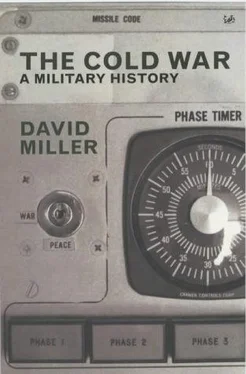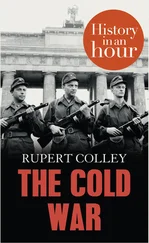Conventional powerA propulsion or generating system which does not use nuclear power. Usually applied to ships and submarines.
Conventional warA war in which nuclear weapons are not used.
Conventional warheadA non-nuclear warhead , normally high-explosive.
Corps See Army formations and units .
Counter-forceDescribes strategic attacks using nuclear weapons directed against enemy weapons and military forces, especially nuclear-weapon delivery systems.
Counter-valueDescribes the use of strategic forces to attack selected enemy population centres, industries and other resources which constitute the essential fabric of the nation.
CPSUCommunist Party of the Soviet Union.
Cruise missileA missile which flies for long distances supported by lift from the wings and/or body. Power is provided by an air-breathing engine, such as a turbojet. Cruise missiles could be launched from aircraft (ALCM = air-launched cruise missile), the ground (GLCM), ships or submarines (SLCM).
DeterrenceA political and military strategy designed to prevent potential enemies from taking armed action, or, if conflict should break out, to prevent it from escalating.
DisplacementThe displacement of a warship is the mass of water displaced by a ship’s hull when floating. In this book the displacement given for surface warships is the ‘standard’ figure – i.e. when the ship is fully manned and stored, but without fuel or reserve feed-water for boilers. The figure is expressed in tonnes, using published figures for navies using the metric system and imperial tons or US short tons converted to metric tonnes in the case of British and US warships. For submarines the displacement is given for the submarine when submerged.
DivisionSee Army formations and units .
Dual capableAble to carry either nuclear or conventional bombs/missiles (aircraft) or warheads (missiles/guns).
ECCMElectronic counter-countermeasures – a form of electronic warfare designed to overcome enemy use of ECM and thus permit continued use of the electromagnetic spectrum.
ECMElectronic countermeasures – a form of electronic warfare designed totally or partially to prevent effective use by the enemy of the electromagnetic spectrum.
ELINTElectronic intelligence – intelligence derived from enemy electronic emissions other than telecommunications (e.g. radar). See also SIGINT .
EMPElectromagnetic pulse – a sharp pulse of radio-frequency electromagnetic radiation produced by a nuclear explosion.
EMTEquivalent megatonnage – a measure of damage by nuclear weapons against ‘soft targets’ such as cities.
Enhanced radiation (ER) – describes a nuclear weapon designed to release about 80 per cent of its yield in high-energy neutrons, resulting in a weapon more dangerous to people than to military equipment or structures. Also known as the ‘neutron bomb’.
ERSee Enhanced radiation .
First strikeThe first offensive move in a conflict. As applied to nuclear warfare, it implies an attempt to eliminate effective retaliation by the enemy.
Flexible responseA strategy based on the capability to act effectively across the entire spectrum of war, at the time, place and manner of the user’s choosing.
FOBSFractional Orbital Bombardment System – a nuclear warhead delivered by a partial orbit, enabling the approach to be made from any direction.
FratricideThe situation when more than two nuclear warheads arrive nearly simultaneously at the same target, and the first warhead to explode therefore either destroys or diverts the following warhead(s).
FRGFederal Republic of Germany – during the period covered by this book, West Germany (Bundesrepublik Deutschland).
Front endThe forward part of a missile, containing the post-boost vehicle, warheads, penetration aids , etc.
GDRGerman Democratic Republic – East Germany (Deutsche Demokratik Republik).
General warArmed conflict involving the two superpowers.
GLCMGround-launched cruise missile .
GSFGGroup of Soviet Forces Germany.
GZGround zero – the point on the earth’s surface upon, above or below which a nuclear explosion takes place. All effects of the explosion are expressed at distances from GZ.
HardenedProtected against the effects of nuclear weapons. This term was usually applied to ‘hardened aircraft shelters’ (HAS), ‘hardened equipment shelters’ (HES), pilot briefing facilities (PBF), etc.
HardnessThe ability of a target to withstand a nuclear explosion and its effects of shock, heat, radiation and EMP . Normally expressed in terms of overpressure withstood in kgf/cm 2.
HEHigh explosive.
Hot launchA launch in which a missile is expelled from the launch tube using the missile’s main motor. See also Cold launch .
IBMSee IRBM .
ICBMIntercontinental [range] ballistic missile – a land-based missile with a range in excess of 3,000 nautical miles (5,560 km).
ICVInfantry combat vehicle – an armoured vehicle designed to carry between six and ten infantrymen, who were able to fire their weapons from within the vehicle. Sometimes also known as ‘mechanized-infantry combat vehicle’ (MICV).
INFIntermediate-range nuclear forces – e.g. IRBM s.
InfantryInfantry are troops who, traditionally, capture ground in the attack and hold ground in the defence. In the Cold War the designation ‘infantry’ was frequently qualified to indicate their method of transportation:
• Mechanized infantry. Troops whose basic means of transport was infantry combat vehicles.
• Motorized infantry. Troops which moved in wheeled vehicles.
• Motor-rifle. English translation of the Russian designation of mechanized infantry; applied to Warsaw Pact forces only.
• Panzer grenadiers. West German designation for troops mounted in infantry combat vehicles and who were capable of fighting from those vehicles.
INRInitial nuclear radiation.
IRBMIntermediate-range ballistic missile – a land-based missile with a range between 1,500 nautical miles (2,780 km) and 3,000 nautical miles (5,560 km). In about 1980 this term changed to ‘IBM’.
KnotA speed of one nautical mile per hour.
KTKiloton – see Yield .
LANDJUTLand Forces Jutland (NATO).
Launch-on-warningStrategic retaliation using ICBM s on receiving information of incoming hostile ballistic missiles . The aim was for the retaliating ICBMs to be clear of their silos before the hostile missiles arrived, thus ensuring their survival and continued flight to their targets.
Launch-under-attackStrategic retaliation using ICBM s in which the missiles would be launched while actually under attack. This implies that the executive decision to launch has not been given in sufficient time to achieve launch-on-warning .
Launch weightThe total weight of a fully loaded missile at the time of launch, including boosters, post-boost vehicle and warheads .
Читать дальше












